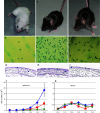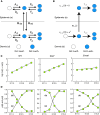Modeling melanoblast development
- PMID: 22915137
- PMCID: PMC11113344
- DOI: 10.1007/s00018-012-1112-4
Modeling melanoblast development
Abstract
Melanoblasts are a particular type of cell that displays extensive cellular proliferation during development to contribute to the skin. There are only a few melanoblast founders, initially located just dorsal to the neural tube, and they sequentially colonize the dermis, epidermis, and hair follicles. In each compartment, melanoblasts are exposed to a wide variety of developmental cues that regulate their expansion. The colonization of the dermis and epidermis by melanoblasts involves substantial proliferation to generate thousands of cells or more from a few founders within a week of development. This review addresses the cellular and molecular events occurring during melanoblast development. We focus on intrinsic and extrinsic factors that control melanoblast proliferation. We also present a robust mathematical model for estimating the doubling-time of dermal and epidermal melanoblasts for all coat color phenotypes from black to white.
Figures


References
-
- Lamoreux ML, Delmas V, Larue L, Bennett D. The colors of mice: a model genetic network. New York: Wiley; 2010.
-
- Le Douarin N, Kalcheim C. The neural crest. Cambridge: Cambridge University Press; 1999.
Publication types
MeSH terms
LinkOut - more resources
Full Text Sources

